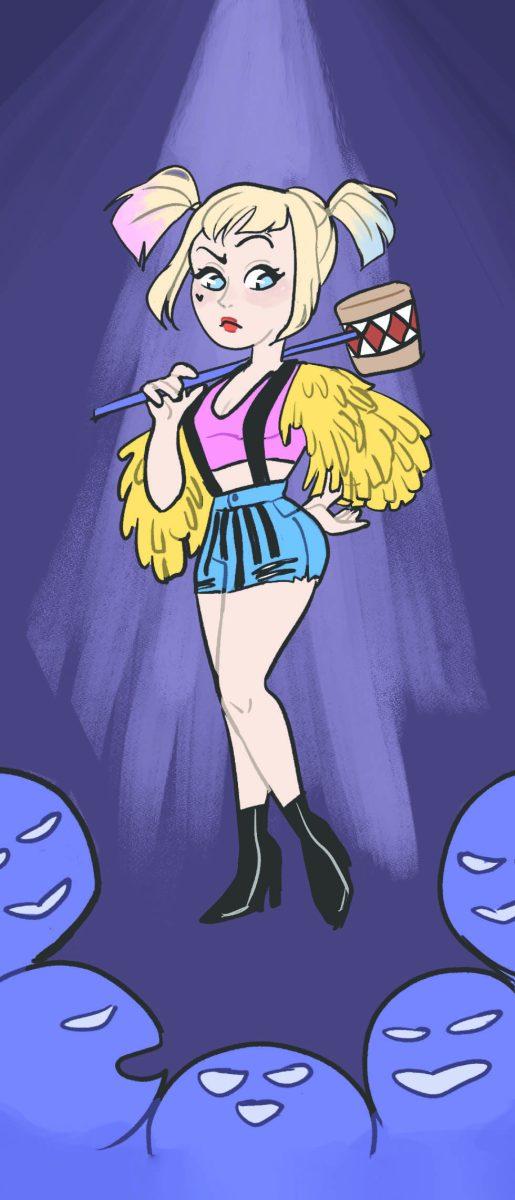
Graphic by Cecilia Romero
Why ‘Birds of Prey’ revolutionizes the female superhero
“Birds of Prey (and the Fantabulous Emancipation of One
Harley Quinn)” received an audience and critic rating of almost 80% on Rotten
Tomatoes and was deemed “the funniest comic book film since the first
‘Deadpool’ from 2016” by New York Post film critic Johnny Oleksinski. The new
film was well received by critics despite being the lowest grossing film within
its franchise on opening weekend. With a mostly female cast — led by Margot
Robbie as protagonist Harley Quinn — audiences witness how the women find
strength among themselves. On the surface, this film has themes of feminine
empowerment and the courage to overcome the oppression of the masculine
counterpart. Even so, is “Birds of Prey” a genuine chick-flick to watch with
the girls, or is it an exploitation of the female body in order to please the
male audience?
To truly grasp what’s going on in “Birds of Prey,” let’s
look into previous superhero movies. While there are numerous films adapted
from DC and Marvel comics, only a couple of them center themselves around
female heroes. The films that most likely sound familiar are “Catwoman” and
“Elektra,” and neither of them did well in the critical sense. In those movies,
the female characters are put into tight outfits that emphasize the female
figure. The women cast into these roles typically have an hourglass shape, as
opposed to a “pear” or “apple” body type. This extreme emphasis of female
attributes, though appealing to the male audience, could not outweigh the awful
special effects or story writing. Film critic Scott Mendelson went so far as to
say that these types of films are what killed off the notion of a female led
superhero movie for just over a decade.
Next came the current superhero franchises many are invested
in today, known as the DC Extended Universe and the Marvel Cinematic Universe.
Those started up with the releases of “Man of Steel” and “Iron Man,”
respectively. In these new series, movies released with a plot centered around
a female character include “Wonder Woman,” “Captain Marvel” and “Birds of
Prey,” all of which received generally high praise amongst critics. In terms of
apparent sexualization of these women, the eye is still drawn to the chest due
to costume design — the star on Captain Marvel’s outfit, the “W” on Wonder
Woman’s outfit — but they’re toned down more than previous designs and cover
more skin. In order to get a sense of how current female superhero films work,
let’s take a look at the recently hatched “Birds of Prey.”
On the surface, the film’s storyline is about female
empowerment. Harley and her friends were wronged by men, and they team up to
fight the bad men in the film. It’s a great way to appeal to the female
audience, but does the film actually have an active presence of women? This can
be indicated by the Bechdel test, which — in order for a film to “pass” — must
feature at least two women who talk to each other about something other than a
man. “Birds of Prey” does in fact feature more than two women who talk to each
other. It’s the third part of the requirement that causes the film to barely
pass the Bechdel test. The women talk about men for a good amount of the film,
though it’s mostly because the people they fight are all men. However, it
doesn’t prevent them from sporting dramatic and exciting outfits and showing
off their fighting skills. With that, the film is able to provide the female
audience a set of dynamic characters to watch.
While this film gives the female superhero fanatics
something to watch, this film also needs to appeal to its male audience. It
does so by providing the two main elements most men gravitate toward: violence
and a sexy body. By doing this, the movie feeds into the feminist theory of the
“male gaze.” This is just a simple way of saying the film depicts women as
sexual objects for the pleasure of the male audience. That might explain the
naked women on the walls of Roman’s office, as well as a couple of costume gags
Harley pulls in the final fight scene.
Even so, this film doesn’t necessarily feed into the male
gaze for the entire runtime. In addition to playing the lead role, Margot
Robbie both pitched and produced this film. There’s a clear difference in
Harley’s character from “Suicide Squad” to “Birds of Prey.” There’s her
dependency on the Joker, which changed once they broke up and gave her a
freedom she never thought she wanted. There’s also her infamous “Suicide Squad”
outfit. Her “Daddy’s Little Monster” shirt with 20 or so holes, along with her
shorts that barely even counted as shorts, both of which Robbie was
uncomfortable with. Transitioning into her life of independence, Harley begins
with a crop and actual shorts. At the end of “Birds of Prey,” she’s wearing a
tank top with overall-type pants. By putting two and two together, there’s a
clear correlation between her outfits and how far she’s ventured into her
newfound independence.
In essence, “Birds of Prey” is a story of female empowerment
that follows the protagonist in her transition from Joker’s girl to “Harley
freaking Quinn,” as she says in the trailers. It’s a huge step from previous
female led superhero films. The DCEU and MCU are undergoing a transition from
sexualized superheroes to ones that have a clear character arc. If audiences
can support the transition of these franchises, one where there will be more
heroines, we would eventually see an equal amount of super-men and
super-ladies. This could essentially lead into a more inclusive universe, where
virtually anyone could be a superhero.